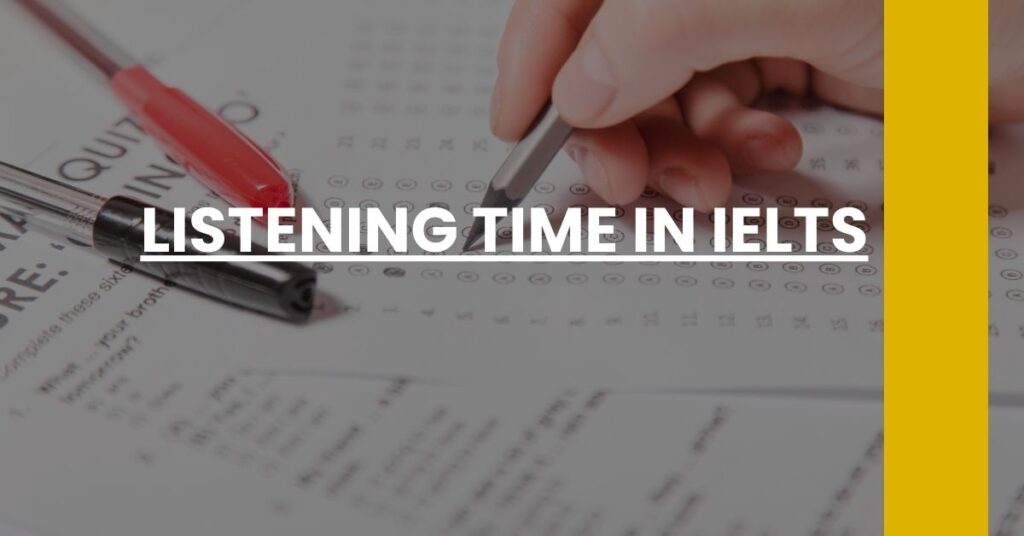Listening time in IELTS is a pivotal factor for high scores. Master this skill, and you’ll enhance your exam performance drastically.
- Prioritize Listening Tasks: Quickly identify key information to optimize your listening time in IELTS.
- Understand Question Types: Familiarize yourself with various question formats to manage listening time effectively.
- Strategic Practice: Hone your listening skills through targeted practice reflecting actual IELTS time constraints.
Efficiently managing your listening time in IELTS paves the way for success.
- Understanding IELTS Listening Section Format and Time Allocation
- Strategies to Maximize Listening Time Efficiency
- Common Time-Related Challenges in IELTS Listening
- Preparing for Different Listening Situations Within Time Constraints
- Practice Techniques to Improve Time Management in Listening
- Utilizing Mock Tests to Calibrate Your Listening Time Efficiency
- Time-Saving Tips During the IELTS Listening Test
- Conclusion: Embracing Listening Time Management for IELTS Advancement
Understanding IELTS Listening Section Format and Time Allocation
Embarking on the journey towards IELTS success, you’ll find time management to be an indispensable ally, particularly within the listening section. Understanding the format and how to allocate your time effectively not only elevates your test performance but ensures a more composed and assured experience.
What Awaits You in the Listening Section?
The IELTS Listening section, lasting about 30 minutes, is structured into four parts that include conversations and monologues across various contexts. These could range from daily social dialogues to academic discussions and lectures. The section culminates with 40 questions designed to test a wide array of listening skills.
- Duration Breakdown: The actual test runs for about 30 minutes, plus an additional 10 minutes allotted exclusively for transferring your answers to the answer sheet in the paper-based test. If you’re taking the computer-based version, the reviewing and checking phase is integrated within these 30 minutes.
How Time is Managed in the Listening Test
As you journey through the IELTS Listening section, you’ll notice that the audio is played only once. Thus, your focus and quick reflexes are key. A neat trick is leveraging the brief pauses in the audio— these are your golden moments for reading the following questions and preparing your mind for what is to come.
- Before the Audio Plays: A precious 30 seconds to a minute is given for you to glance through the upcoming batch of questions.
- In Between Sections: Minor pauses allow you to check your answers and anticipate next questions.
- After the Audio: Depending on your test method—paper or computer-based—you’ll have time to review and ensure your answers are well crafted and correctly placed.
Navigating the Questions
In an environment where every second counts, analyzing each question type swiftly is a strategy that serves well. Recognize that certain question types, such as multiple-choice, may eat into your time more than others. However, formats like matching tend to be quicker once you’ve grasped the core content.
Strategies to Maximize Listening Time Efficiency
Maximizing efficiency during the IELTS listening test isn’t simply a wish—it’s a skill that can be honed with the right tactics. It begins even before the speaker starts, where anticipating the content based on hints from the questions and possible answers can place you a step ahead.
Anticipate and Visualize
Imagine stepping into the exam already having a sense of the directions a conversation might take. By reviewing the types of questions, you can prepare your mind to extract relevant information briskly and accurately. This strategic anticipation saves precious moments you might otherwise spend puzzling over the context or content.
- Look for Keywords: Keywords in the questions will often signal what to listen for in the recordings.
- Identify Signposts: Phrases that indicate a contrast, reason, or a sequence help you pinpoint essential information quicker.
Managing Your Answer Sheet
It’s tempting to make your answer sheet impeccable with neat handwriting and meticulously darkened bubbles. However, remember, perfection is not the goal here—accuracy under time constraints is. Prioritize getting your answers down first and reserve finessing your answer sheet for the review time.
- Quick Transfers: If you’re writing, get your answers down fast, then tidy them up later within the review period.
- Staying Alert: Keep an ear out for correctors or repeat information, as they are your cues to update answers if needed.
Common Time-Related Challenges in IELTS Listening
It’s common to encounter hurdles when managing listening time in IELTS. Knowing what these potential pitfalls are, and how you can steer clear of them, is half the battle won.
The Challenge of the Clock
The IELTS listening test is unforgiving with its one-chance-only policy. Once the audio moves forward, so does the clock. Understanding this, it’s vital to remain alert and resilient, ready to capture key points without lamenting over missed ones.
- Distraction: A brief lapse in concentration can mean losing out on answers. Stay sharp, and maintain focus.
- Overthinking: Don’t get stuck dissecting one tough question. Make an educated guess and proceed, as you can always revisit it later.
Identifying Trouble Spots
Sections that feature dense, academic language or a rapid exchange can muddle your time efficiency. By practicing under these specific circumstances, you develop a keener ear to sift through the noise and pinpoint the necessary details.
- Complex Input: Train your ear with practice audios that include technical jargon or accents unfamiliar to you.
- Swift Interactions: Enhance your ability to follow quick dialogues by exposing yourself to natural-speed conversations.
In summary, as you sharpen your strategies for managing listening time in IELTS, meld these targeted tactics with consistent practice, and embody patience and persistence. Remember, your command over time might just be the deciding factor in achieving the score that’ll open new doors for you.
Preparing for Different Listening Situations Within Time Constraints
The IELTS Listening test demands that you navigate through different listening scenarios while adhering to strict time limitations. Your ability to adapt to each situation will greatly influence your listening time in IELTS. From engaging in natural conversations to understanding complex academic talks, each requires a unique approach to time management.
Adjusting to Conversations
When you encounter dialogues or group discussions, shift your listening gear to catch nuances and attitudes. Here’s how you can manage:
- Predict the Flow: Based on the initial introduction, try to predict possible topics and responses.
- Track the Speakers: Mentally note who is speaking to map out the exchange clearly.
Comprehending Monologues
The dreaded monologues: a single speaker delivering a lengthy talk. To stay engaged through these, consider:
- Outline Main Ideas: Jot down key points as you listen, which helps retain focus and structure your time efficiently.
- Filter the Fluff: Not every detail is crucial. Learn to recognize and note only what’s relevant to the questions.
Dealing with Accents and Pacing
The variety of accents and pace adds to the challenge. To overcome this:
- Accent Acclimatization: Immerse yourself in audio resources featuring diverse accents to raise your adaptability.
- Pacing Practice: Listen to podcasts at different speeds to train your ear for any pacing scenario.
Practice Techniques to Improve Time Management in Listening
Your practice regime should be strategic, targeting both your listening skills and time management abilities. Let’s look at how a rigorous practice routine can boost your efficiency during the actual listening time in IELTS.
- Simulate Real Test Conditions: Regularly practice with materials that recreate the exact test conditions, including timing and environment.
- Review and Reflect: After each practice test, review your answers and analyze where you stumbled with time or understanding.
- Incorporate Variety: Ensure your practice includes a wide range of listening situations and question types.
Widely-used resources like IELTS Liz offer a vast collection of practice exercises that cater to the specific needs of IELTS candidates.
Utilizing Mock Tests to Calibrate Your Listening Time Efficiency
Full-length mock tests are an invaluable tool for mastering listening time in IELTS. They do more than just accustom you to the format; they reveal your strengths and highlight areas needing improvement.
- Replicate Testing Experience: Attempt these mocks under real-time conditions to gauge your listening response and timing.
- Track Performance: Assess your speed and accuracy by the number of right answers within the time frame.
- Adjust Tactics: Use the results to refine your test-taking strategies, focusing on sections where your time management needs work.
In the days leading up to your test, make IELTS Online Practice Tests a cornerstone of your preparation.
Time-Saving Tips During the IELTS Listening Test
On your quest to make the most of your listening time in IELTS, every second counts. Here are some tips to shave off precious moments and enhance your efficiency.
- Read Instructions Quickly: Glance over the command words to understand what’s needed without dwelling too long.
- Use Shortcut Annotations: Develop a system of symbols or abbreviations for quick note-taking.
- Stay One Step Ahead: Anticipate the next question as you answer the current one, keeping the momentum going.
Managing your listening time in IELTS is a balancing act of staying attentive and thinking ahead.
Conclusion: Embracing Listening Time Management for IELTS Advancement
Your listening time in IELTS is a resource that, when managed skillfully, can significantly elevate your score. By integrating the time management strategies outlined above, you’re not just preparing for an exam; you’re cultivating a skill set that will benefit you far beyond the IELTS. Your proficiency in managing listening time effectively can lead to a ripple effect of improved comprehension and sharper focus in various aspects of personal and professional life. So, embrace these practices with conviction, and watch as your IELTS outcomes transform alongside your listening expertise.
Master listening time in IELTS with effective strategies to enhance performance and achieve higher scores in the listening section.

